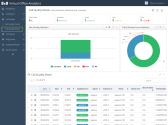Get Call Quality Details
Note: Available for 8x8 Work Service Quality Managers only.
Has your call center been having trouble with call quality? With the Call Quality Details report, get a bird's-eye view of the overall call quality of your call center, and then quickly drill down to individual agent call quality to spot problem areas and improve service. This way, you can easily review individual call quality and consolidated MOS![]() Mean Opinion Score provides a numerical measure of the quality of human speech at the destination end of the circuit. score details in graphical format and granular detail to better resolve call quality issues in your call center.
Mean Opinion Score provides a numerical measure of the quality of human speech at the destination end of the circuit. score details in graphical format and granular detail to better resolve call quality issues in your call center.
Features
- Analyze call quality trends and generate related reports.
- Review voice quality scores to ensure good audio quality and balanced call volume.
- View data on voice quality, consolidated or for individual calls, and analyze how to resolve persistent issues that show up.
Note: The Call Quality Trend and Call Quality Detail reports use different timezones. The Call Quality Trend report uses the date window based on UTC time, while Call Quality Detail uses Australian Time Zone. As a result, you may notice some differences in data between Call Quality Trend and Call Quality Detail reports.
Call Quality Trend
This report captures call quality of all calls in your phone system over several days or months to better help you track changes in call quality. You can generate a report for a specific date range (daily, monthly, or yearly) in order to narrow down and find the source of irregularities in call quality. This way, you can take action to improve the effectiveness of your call center.
Features
- Analyze call quality trends and generate related reports.
- Narrow down or widen the date range for the report to find the source of irregularities in call quality.
Voice Quality Score
The definition of Voice Quality Score is based on conversation and listening MOS score. The following table has definition of the VQ Score, and the corresponding MOS Score range.
| VQ Score | MOS Score |
|---|---|
| Excellent | 4.0-5.0 |
| Good | 3.0-4.0 |
| Fair | 2.5-3.0 |
| Poor | 1.5-2.5 |
| Very Poor | 0.1-1.5 |
| N/A(NA) | 0.0/127 |
The report also tracks call volume ratio and poor quality ratio.
- Call Volume Ratio: Call volume / Average call volume for the selected date range
If the ratio is greater than 1, it indicates that the number of calls handled by the phone system is greater than the average number of calls. - Poor Quality Ratio: Number of poor quality calls / Total call volume for the selected date range
Smaller ratios indicate an overall high call quality.
Call Quality Details
The Call Quality reports offer individual call and consolidated Mean Opinion Score (MOS) detail in graphical format and granular detail for trouble analysis and resolution. Voice Quality Score is based on conversation and listening MOS. The MOS provides a numerical measure of the quality of human speech at the destination of the circuit.
Glossary: Call Quality Details
The following table displays some of the most important parameters in a voice quality report.
| Column | Description |
|---|---|
| Date | Date of call. |
| Start | Start time of the call. |
| End | End time of the call. |
| QualityScore | MOS quality rating. MOS measures the quality of human speech at the destination of the circuit. |
| IpbxId | Phone system identifier. |
| Extension | Phone system extension number involved in the call. |
| PeerNumber | The IP address, port, and SSRC of the session peer from the perspective of the remote endpoint that measures performance. |
| NLR% | Network packet loss ratio, in percentage. |
| JDR% | Packet ratio discarded from the jitter buffer, in percentage. Packet Loss occurs primarily due to handling jitter. |
| JBN | This is the current nominal jitter buffer delay in milliseconds, which corresponds to the nominal jitter buffer delay for packets that arrive exactly on time. Added latency occurs primarily due to handling jitter. |
| Payload | RTP |
| UserAgent | Endpoint device model and firmware information. |
| SiteLocation | The originating location for the call. |
| PublicIP | The Public IP address of origination. |
| RouteLocation | The next location in the call path route. |
| RouteIP | The Public IP address of next location in the call path route. |